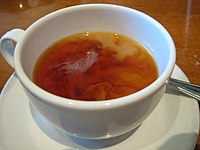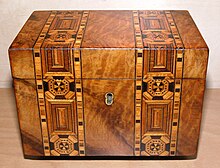Tea in the United Kingdom: Difference between revisions
No edit summary |
→British tea ritual: Removed "for several minutes" |
||
| Line 16: | Line 16: | ||
# Water is swirled around the pot to warm it and then poured out. |
# Water is swirled around the pot to warm it and then poured out. |
||
# Loose tea leaves—nowadays often [[tea bag]]s or the dust from a ripped-open tea bag—are then added to the pot. |
# Loose tea leaves—nowadays often [[tea bag]]s or the dust from a ripped-open tea bag—are then added to the pot. |
||
# Water is added to the pot and allowed to brew |
# Water is added to the pot and allowed to brew while a [[tea cosy]] is placed on the pot to keep the tea warm. |
||
# Milk may be added to the tea cup, the host asking the guest if milk is wanted, although milk may alternatively be added after the tea is poured. |
# Milk may be added to the tea cup, the host asking the guest if milk is wanted, although milk may alternatively be added after the tea is poured. |
||
# A tea strainer, like a miniature sieve, is placed over the top of the cup and the tea poured in. |
# A tea strainer, like a miniature sieve, is placed over the top of the cup and the tea poured in. |
||
Revision as of 21:02, 19 November 2010

The British are the largest per capita tea consumers in the world, with each person consuming on average 2.5 kg per year.[1] The popularity of tea dates back to the 19th century when India was part of the British Empire, and British interests controlled tea production in the subcontinent. It was, however, first introduced in Britain by Catherine of Braganza, queen consort of Charles II of England in the 1660s and 1670s. As tea spread throughout the United Kingdom people started to have tea gardens and tea dances. These would include watching fireworks or a dinner party and dance, concluding with a nice evening tea. The tea gardens lost value after World War II but tea dances are still held today in the United Kingdom.
Tea is usually black tea served with milk (never cream) and sometimes with sugar. Strong tea served with lots of milk and often two teaspoons of sugar, usually in a mug, is commonly referred to as builder's tea. Much of the time in the United Kingdom, tea drinking is not the delicate, refined cultural expression that the rest of the world imagines—a cup (or commonly a mug) of tea is something drunk often, with some people drinking as many as 6 or more cups of tea a day. Employers generally allow breaks for tea and sometimes biscuits to be served.
Brief History
Before it became Britain’s number one drink, tea was mainly consumed by the fashionably rich. Introduced for the first time in British society in 1662 by Catherine of Braganza at Stuart court people soon started to adopt the new trend and the act of drinking tea quickly spread throughout the English bourgeoisie [2] . A few years later, as the British Empire grew many new goods from eastern countries including tea were imported into the country. Between 1720 and 1750 the imports of tea to Britain from the East India Company more the quadrupled [3] . Tea was particularly interesting to the Atlantic world not only because it was easy to cultivate but also because of how easy it was to prepare and its ability to revive and cure mild colds [4].
Between 1872 and 1884 the supply of tea to the empire had increased with the expansion of the British Empire’s railroad to the east. The demand however was not proportional, which caused the prices to rise. Nevertheless, from 1884 onward due to new innovation in tea preparation the price of tea dropped and remained relatively low throughout the first half of the 20th century. Soon afterwards London became the center of international tea trade [5]. With high tea imports also came a large increase in the demand for porcelain . The demand for tea cup, pots and dishes increased to go along with this popular new drink. [6]. Now, people in Britain drink tea multiple times a day. As the years passed it became a drink less associated with high society as people of all classes drink tea today which can be enjoyed in many different flavours and ways.
British tea ritual
Even very slightly formal events can be a cause for cups and saucers to be used instead of mugs. A typical semi-formal British tea ritual might run as follows (the host performing all actions unless noted):
- The kettle is boiled and water poured into a tea pot.
- Water is swirled around the pot to warm it and then poured out.
- Loose tea leaves—nowadays often tea bags or the dust from a ripped-open tea bag—are then added to the pot.
- Water is added to the pot and allowed to brew while a tea cosy is placed on the pot to keep the tea warm.
- Milk may be added to the tea cup, the host asking the guest if milk is wanted, although milk may alternatively be added after the tea is poured.
- A tea strainer, like a miniature sieve, is placed over the top of the cup and the tea poured in.
- The straight black tea is then given to guests and they are allowed to add milk and sugar to their taste.
- The pot will normally hold enough tea so as not to be empty after filling the cups of all the guests. If this is the case, the tea cosy is replaced after everyone has been served.
Whether to put milk into the cup before or after the tea is, and has been since at least the late 20th century, a matter of some debate with claims that adding milk at the different times alters the flavour of the tea.
There is also a proper manner in which to drink tea when using a cup and saucer.[citation needed] If one is seated at a table, the proper manner to drink tea is to raise the teacup only, placing it back into the saucer in between sips. When standing or sitting in a chair without a table, one holds the tea saucer with the off hand and the tea cup in the dominant hand. When not in use, the tea cup is placed back in the tea saucer and held in one's lap or at waist height. In either event, the tea cup should never be held or waved in the air.
Drinking tea from the saucer (poured from the cup in order to cool it) was not uncommon at one time but is now almost universally considered a breach of etiquette.

Tea as a meal
Tea is not only the name of the beverage, but of a late afternoon light meal, irrespective of the beverage consumed. Anna Russell, Duchess of Bedford is credited with the creation of the meal circa 1800. She thought of the idea to ward off hunger between lunch and dinner. The tradition continues to this day.
There used to be a tradition of tea rooms in the UK which provided the traditional fare of cream and jam on scones, a combination commonly known as cream tea. However, these establishments have declined in popularity since World War II. In Devon and Cornwall particularly, cream teas are a speciality. A.B.C. tea shops and Lyons Corner Houses were a successful chain of such establishments. It is a common misconception that cream tea refers to tea served with cream (as opposed to milk). This is certainly not the case. It simply means that tea is served with a scone with clotted cream and jam.

Industrial Revolution
Some scholars suggest that tea played a role in British Industrial Revolution. Afternoon tea possibly became a way to increase the number of hours labourers could work in factories; the stimulants in the tea, accompanied by sugary snacks, would give workers energy to finish out the day's work. Further, tea helped alleviate some of the consequences of the urbanization that accompanied the industrial revolution: drinking tea required boiling one's water, thereby killing water-borne diseases like dysentery, cholera, and typhoid.[7]
Tea cards
In the United Kingdom a number of varieties of loose tea sold in packets from the 1940s to the 1980s contained tea cards. These were illustrated cards roughly the same size as cigarette cards and intended to be collected by children. Perhaps the best known were Typhoo tea and Brooke Bond (manufacturer of PG Tips), the latter of whom also provided albums for collectors to keep their cards in. Some renowned artists were commissioned to illustrate the cards including Charles Tunnicliffe. Many of these card collections are now valuable collectors' items.
Tea today
In 2003, Datamonitor reported that regular tea drinking in the United Kingdom was on the decline.[1] There was a 10¼ percent decline in the purchase of normal teabags in Britain between 1997 and 2002.[1] Counter-intuitively, it was not coffee that was filling the gap since the sales of ground coffee also fell during the same period.[1] Britons were instead filling the warm drinks void with health-oriented beverages like fruit and/or herbal teas, consumption of which increased 50 percent from 1997 to 2002.[1] A further, unexpected, statistic is that the sales of decaffeinated tea and coffee fell even faster during this period than the sale of the regular varieties.[1]
Further reading
- Julie E. Fromer. A Necessary Luxury: Tea in Victorian England (Ohio University Press, 2008), 375pp
References
- ^ a b c d e f “Britons have less time for tea,” Food & Drink. 16 June 2003. (Retrieved 2010-05-16.)
- ^ Guerty, P. M., and Kevin Switaj. 2004. Tea, porcelain, and sugar in the british atlantic world. OAH Magazine of History 18 (3) (04): 56-9.
- ^ Walvin, James. 1997. A taste of empire, 1600-1800. (cover story). History Today 47 (1) (01): 11.
- ^ Guerty, P. M., and Kevin Switaj. 2004. Tea, porcelain, and sugar in the british atlantic world. OAH Magazine of History 18 (3) (04): 56-9.
- ^ Nguyen, D. T., and M. Rose. 1987. Demand for tea in the UK 1874-1938: An econometric study. Journal of Development Studies 24 (1) (10): 43.
- ^ Guerty, P. M., and Kevin Switaj. 2004. Tea, porcelain, and sugar in the british atlantic world. OAH Magazine of History 18 (3) (04): 56-9.
- ^ Tea and the Industrial Revolution
